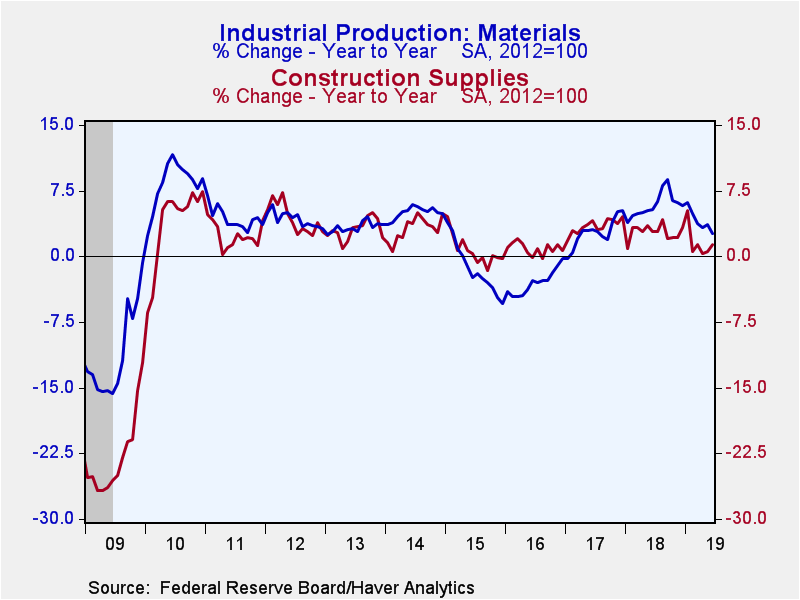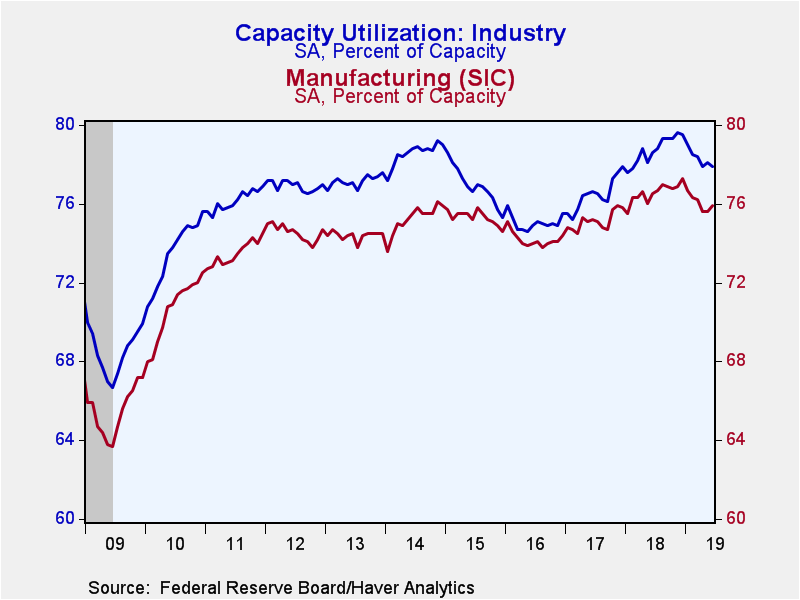 Global| Jul 16 2019
Global| Jul 16 2019U.S. Industrial Production Unchanged in June as Utility Output Falls
Summary
Industrial production was flat during June (+1.3% year-on-year) following an unrevised 0.4% gain in May. April was revised down slightly to -0.5% from -0.4%. The Action Economics Survey forecast a 0.2% gain in June. Manufacturing [...]
Industrial production was flat during June (+1.3% year-on-year) following an unrevised 0.4% gain in May. April was revised down slightly to -0.5% from -0.4%. The Action Economics Survey forecast a 0.2% gain in June.
Manufacturing activity rose 0.4% (0.4% y/y) during June, after a 0.2% gain in May (unrevised). Utilities output dropped 3.6% (-2.6% y/y) as the number of cooling days returned to normal, after an above-normal reading in May, when utility output jumped 2.4%. Meanwhile mining activity increased 0.2% (8.7% y/y) for the second consecutive month.
The rise in manufacturing production was supported by a 0.4% increase in durables (1.4% y/y), with a 2.9% gain in motor vehicles (2.4% y/y) offsetting a 1.0% drop in machinery (+0.5% y/y). Both aerospace and computer output rose 0.9% (1.9% and 5.3% y/y respective). Nondurable output grew 0.5% (-0.5% y/y) as petroleum & coal jumped 2.5% (0.2% y/y), chemicals ticked down 0.1% (+0.9% y/y), and food increased 0.7% (-1.0% y/y).
By market group, consumer goods output was unchanged in June (-0.7% y/y), while business equipment and construction supplies both grew 0.5% (1.8% and 1.4% y/y respectively). Materials output declined 0.2% (+2.6% y/y) driven by a 0.9% drop in energy materials (+6.0% y/y).
In the special aggregate groupings, production of high technology products increased 0.7% (5.1% y/y). Semiconductor & electronic components gained 0.9% (3.2% y/y) and communications equipment grew 0.2% (14.7% y/y). Output in computer & office equipment was up 0.8% (-0.7% y/y) and stands just slightly above 2008 levels. Factory sector production excluding the motor vehicle and high tech sectors edged up 0.1% (+0.1% y/y) but is still 11% below its 2007 peak.
Capacity utilization declined to 77.9% in June from 78.1%. The Action Economics Survey expected an unchanged reading. Factory sector use rose to 75.9%, though it is down 1.4 percentage points from December's cyclical peak. Mining decreased to 91.5% well below the cycle high of 93.3% in December. Growth in capacity in the manufacturing sector continues to strengthen, up 1.2% y/y, though capacity is still slightly below its 2008 peak.
Industrial production and capacity data and US Population-Weighted Heating and Cooling Days are included in Haver's USECON database. Additional detail on production and capacity can be found in the IP database. The expectations figures come from the AS1REPNA database.
| Industrial Production (SA, % Change) | Jun | May | Apr | Jun Y/Y | 2018 | 2017 | 2016 |
|---|---|---|---|---|---|---|---|
| Total Output | 0.0 | 0.4 | -0.5 | 1.3 | 3.9 | 2.3 | -2.0 |
| Manufacturing | 0.4 | 0.2 | -0.7 | 0.4 | 2.3 | 2.0 | -0.8 |
| Consumer Goods | 0.0 | 0.5 | -1.7 | -0.7 | 2.1 | 0.5 | 0.6 |
| Business Equipment | 0.5 | 0.4 | -1.5 | 1.8 | 3.2 | 3.6 | -5.3 |
| Construction Supplies | 0.5 | 0.6 | -0.8 | 1.4 | 2.8 | 3.5 | 0.9 |
| Materials | -0.2 | 0.4 | 0.5 | 2.6 | 5.9 | 2.7 | -3.0 |
| Utilities | -3.6 | 2.4 | -3.3 | -2.6 | 4.4 | -0.8 | -0.4 |
| Mining | 0.2 | 0.2 | 2.6 | 8.7 | 12.4 | 7.4 | -9.9 |
| Capacity Utilization (%) | 77.9 | 78.1 | 77.9 | 78.6 | 78.7 | 76.5 | 75.0 |
| Manufacturing | 75.9 | 75.6 | 75.6 | 76.5 | 76.6 | 75.1 | 74.2 |
Gerald D. Cohen
AuthorMore in Author Profile »Gerald Cohen provides strategic vision and leadership of the translational economic research and policy initiatives at the Kenan Institute of Private Enterprise.
He has worked in both the public and private sectors focusing on the intersection between financial markets and economic fundamentals. He was a Senior Economist at Haver Analytics from January 2019 to February 2021. During the Obama Administration Gerald was Deputy Assistant Secretary for Macroeconomic Analysis at the U.S. Department of Treasury where he helped formulate and evaluate the impact of policy proposals on the U.S. economy. Prior to Treasury, he co-managed a global macro fund at Ziff Brothers Investments.
Gerald holds a bachelor’s of science from the Massachusetts Institute of Technology and a Ph.D. in Economics from Harvard University and is a contributing author to 30-Second Money as well as a co-author of Political Cycles and the Macroeconomy.









